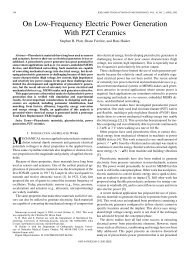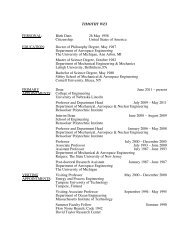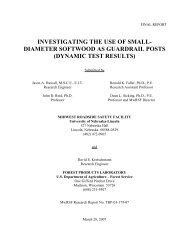Download .pdf of this edition. - College of Engineering - The ...
Download .pdf of this edition. - College of Engineering - The ...
Download .pdf of this edition. - College of Engineering - The ...
You also want an ePaper? Increase the reach of your titles
YUMPU automatically turns print PDFs into web optimized ePapers that Google loves.
TUESDAY, APRIL 8<br />
Meeting Clay Anderson<br />
Today was scheduled as “flight day one” but, due to technical reasons, the flights and<br />
experiments were grounded and postponed to tomorrow.<br />
In the meantime we were treated with an opportunity to meet Clayton C. Anderson, the<br />
Nebraska astronaut who spent a five-month tour <strong>of</strong> duty on board the International Space<br />
Station in 2007.<br />
We showed Clay Anderson our Microgravity RFID Experiment on the C-9 aircraft. During<br />
take-<strong>of</strong>f and landing, the experimenters and crew sat in the seats. <strong>The</strong> experiments were<br />
secured to the white floor <strong>of</strong> the plane.<br />
—Olga Dzenis<br />
Left to right: Dustin Dam, Amy Schellhase, Stephen Brogan,<br />
Lee Redden, Clay Anderson, Tyler Goldberg, Dana Valish<br />
and Olga Dzenis<br />
FLIGHT DAYS!<br />
Amy and Olga “hold up” the<br />
Weightless Wonder IV<br />
Flight 1: Micro Gravity<br />
Amy, Tyler and Dustin were the first to go up. Nebraska led the groups to fly. <strong>The</strong>y looked<br />
serious but they were so excited!<br />
To achieve reduced gravity, the C9 flew parabolas, with ascent and descent about 45<br />
degrees to the Earth’s surface.<br />
Everyone did their part to get the experiment done, and they came <strong>of</strong>f the plane like they<br />
just had the best time <strong>of</strong> their lives.<br />
Flight 2: Micro Gravity<br />
Lee and Stephen were all smiles, boarding the C9. During their flight, they worked hard<br />
using the handheld RFID scanner and spinning the Pantry CTB (crew transport bag).<br />
Flight 3: Lunar Gravity<br />
I was an alternate for my team and, since my group flyers were clear to fly, I was not able<br />
to fly during our experiments due to lack <strong>of</strong> space on the C9. Don’t fret ... the program<br />
director arranged for me to assist another team with their experiment during flight 3. This<br />
flight was for experiments that needed Lunar Gravity (1/6 <strong>of</strong> the Earth’s). At the end <strong>of</strong> the<br />
experimental parabolas, the crew let us experience three zero-G (weightless) parabolas<br />
and one Martian (1/3 <strong>of</strong> the Earth’s) parabola.<br />
Boarding the C9, I was very excited. As I experienced my first lunar gravity parabola,<br />
my hair suddenly had more volume! We got down to business quickly once we got used<br />
to lunar gravity. My responsibility during the experiment was to raise and drop an<br />
accelerometer. Towards the end <strong>of</strong> our parabolas, my group had some time to see how we<br />
were responding to the lunar gravity. I did splits in mid-air.<br />
Getting <strong>of</strong>f the C9, I was even more excited than when I boarded the plane. I had a<br />
fantastic, once-in-a-lifetime experience that day.<br />
—Olga Dzenis<br />
rE-ENTErING THE ACADEMIC ATMOSPHErE<br />
Back in Lincoln in late April, Dam and Brogan summarized<br />
the UNL experiment’s technical aspects: “<strong>The</strong> flight<br />
experiments seemed to go well. We had one glitch with<br />
some hardware but it was a backup item, so we were in<br />
good shape. <strong>The</strong> efficiency <strong>of</strong> the RFID scans appears to be<br />
what we expected: 70-80 percent accuracy on the ‘pantry’<br />
items and 90-95 percent on the clothing items.” <strong>The</strong>y added<br />
that in the next step for the research, Schellhase (the UNL<br />
team’s mentor during the flights, and employed by Berrios,<br />
a NASA contractor) aims to facilitate testing <strong>of</strong> the findings<br />
in the International Space Station.<br />
But the impact went far beyond the data for the UNL group.<br />
In the personal realm, the team gained appreciation for the<br />
challenges NASA surmounts to advance technology and<br />
space exploration, and they are eager to help future UNL<br />
teams gain similar experience with NASA.<br />
Above all, they are very proud <strong>of</strong> their experience—even<br />
the “epic” bouts <strong>of</strong> in-flight nausea (each student reacted<br />
differently; some were sickened by the reduced gravity, but<br />
a few had problems instead with 2G: the “double-gravity”<br />
during pullouts).<br />
Back at UNL, the big challenge for the Microgravity Team<br />
was to catch up with their classes—which felt like a “2G”<br />
effort. Due to the flight timing, the UNL group missed a week<br />
<strong>of</strong> classes, but it was all worth it, Dam and Brogan reflected.<br />
Dam was pleased that in his ELEC 464 course on<br />
digital communications, classes since their return have<br />
explained some <strong>of</strong> the scan challenges, which increased his<br />
understanding. He also reported a convenient catchphrase<br />
gained at NASA—when distracted in the blur <strong>of</strong> resuming<br />
academic life, he applies a term from flight preparation in<br />
the hyperbaric chamber: “I am still a bit hypoxic.”<br />
Most important, looking back shows how their individual<br />
and team learning curves—as steep as the flights’ upward<br />
arcs—made them better engineers. <strong>The</strong>y recall moments<br />
like Test Readiness Review, a 14-person preflight panel <strong>of</strong><br />
NASA experts that peppered the students with difficult<br />
safety questions, but the well-prepared UNL team passed.<br />
Having soared over such hurdles, now the members can add<br />
“government certified researcher” to their résumés.<br />
Pérez also admired the team’s achievements. He watched<br />
with pride as the UNL students ascended and returned,<br />
and concluded: “<strong>The</strong> participation <strong>of</strong> the UNL team in the<br />
2008 NASA SEED Microgravity Program was a rewarding<br />
opportunity that provided our students with a unique<br />
experience in applied research and development.”<br />
“NASA scientists, contractors and other students’ teams<br />
repeatedly commented on the pr<strong>of</strong>essionalism, teamwork<br />
and diligence <strong>of</strong> the UNL team,” said Pérez. “<strong>The</strong> students<br />
gained valuable experience in the areas <strong>of</strong> experimental<br />
design, scientific protocol, data robustness and working<br />
with government and industry in a scientific enterprise.”<br />
<strong>Engineering</strong>@Nebraska 9.







